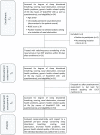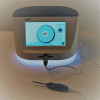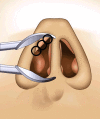A prospective, non-randomized evaluation of a novel low energy radiofrequency treatment for nasal obstruction and snoring
- PMID: 30607559
- PMCID: PMC6426809
- DOI: 10.1007/s00405-018-05270-y
A prospective, non-randomized evaluation of a novel low energy radiofrequency treatment for nasal obstruction and snoring
Abstract
Background: Weak or inward-bent cartilage of the nasal sidewall at the level of the internal nasal valve (INV) can produce narrowness or collapse of the nasal valve. This is a common cause of impaired nasal breathing during daily activities and there is also an established connection between nasal obstruction and snoring. The condition is often difficult to treat, although even a small enlargement of the lumen at the nasal valve can lead to a significant improvement in the ease of nasal breathing.
Methods: The primary objective of this prospective study was to evaluate the safety and efficacy of the Vivaer system for the treatment of narrowed nasal valves and to measure changes in the symptoms of nasal obstruction and snoring. The Vivaer system uses low energy radiofrequency to remodel the nasal sidewall in order to improve airflow.
Results: The study involved 31 patients presenting from 1st September 2017 to 1st May 2018 with symptoms of nasal obstruction and snoring. In all patients, an improvement was observed in nasal breathing measured by NOSE score, sleep quality by SOS questionnaire and quality of life as measured by EQ-5D and SNOT-22.
Conclusion: Vivaer intranasal remodeling can provide a durable and well-tolerated non-invasive treatment for those patients who are suffering congestion due to narrowness or collapse of the INV.
Keywords: Nasal valve; Nose score; Radiofrequency therapy; Snoring.
Conflict of interest statement
Conflict of interest
The authors declare that they have no conflict of interest.
Ethics approval
The study was approved by the Ethics Commission at the University of Witten/Herdecke, Germany.
Informed consent
The study was conducted in accordance with the principles of Goof Clinical Practices and Declaration of Helsinki (1964 and its revisions). Patients who provided written informed consent, were enrolled in the study.
Figures





Similar articles
-
Regional Peak Mucosal Cooling Predicts Radiofrequency Treatment Outcomes of Nasal Valve Obstruction.Laryngoscope. 2021 Jun;131(6):E1760-E1769. doi: 10.1002/lary.29223. Epub 2020 Nov 3. Laryngoscope. 2021. PMID: 33140876
-
Improvement in Snoring-Related Quality-of-Life Outcomes After Functional Nasal Surgery.Facial Plast Surg Aesthet Med. 2020 Jan/Feb;22(1):25-35. doi: 10.1089/fpsam.2019.29002.lin. Facial Plast Surg Aesthet Med. 2020. PMID: 32053426
-
Quality-of-life impact after in-office treatment of nasal valve obstruction with a radiofrequency device: 2-year results from a multicenter, prospective clinical trial.Int Forum Allergy Rhinol. 2021 Apr;11(4):755-765. doi: 10.1002/alr.22667. Epub 2020 Aug 9. Int Forum Allergy Rhinol. 2021. PMID: 32810380 Free PMC article. Clinical Trial.
-
Obstructive sleep apnea, nasal congestion, and snoring: their systemic effects and impact on quality of life.Allergy Asthma Proc. 2004 Jan-Feb;25(1):43-51. Allergy Asthma Proc. 2004. PMID: 15055562 Review.
-
The role of the nose in sleep-disordered breathing.Am J Rhinol Allergy. 2013 May-Jun;27(3):213-20. doi: 10.2500/ajra.2013.27.3876. Am J Rhinol Allergy. 2013. PMID: 23710958 Review.
Cited by
-
The remarkably frequent use of EQ-5D in non-economic research.Eur J Health Econ. 2022 Aug;23(6):1007-1014. doi: 10.1007/s10198-021-01411-z. Epub 2021 Nov 30. Eur J Health Econ. 2022. PMID: 34846623 Free PMC article.
-
Two-year outcomes of temperature-controlled radiofrequency device treatment of the nasal valve for patients with nasal airway obstruction.Laryngoscope Investig Otolaryngol. 2023 Jun 15;8(4):808-815. doi: 10.1002/lio2.1089. eCollection 2023 Aug. Laryngoscope Investig Otolaryngol. 2023. PMID: 37621275 Free PMC article.
-
Could the use of a new novel bipolar radiofrequency device (Aerin) improve nasal valve collapse? A systematic review and meta-analysis.J Otolaryngol Head Neck Surg. 2023 Jun 22;52(1):42. doi: 10.1186/s40463-023-00644-7. J Otolaryngol Head Neck Surg. 2023. PMID: 37349806 Free PMC article.
-
Temperature-controlled radiofrequency treatment of the nasal valve in nasal airway obstruction patients with septal deviation.Int Forum Allergy Rhinol. 2025 Mar;15(3):328-331. doi: 10.1002/alr.23472. Epub 2024 Oct 18. Int Forum Allergy Rhinol. 2025. PMID: 39422052 Free PMC article.
-
Contemporary office-based procedures in rhinology: a narrative review of techniques, indications, and outcomes.Front Allergy. 2025 Jul 18;6:1554792. doi: 10.3389/falgy.2025.1554792. eCollection 2025. Front Allergy. 2025. PMID: 40756135 Free PMC article. Review.
References
MeSH terms
LinkOut - more resources
Full Text Sources
Medical

